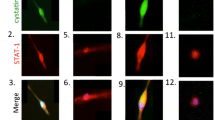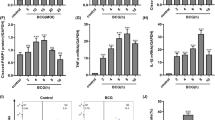Abstract
Toxoplasma gondii provoked rapid and sustained nuclear translocation of signal transducer and activator of transcription (STAT) 6, a central mediator of interleukin (IL)-4, in macrophage-differentiated human acute monocytic leukemia cells without exogenous IL-4 in western blot and immunofluorescence assay. Phosphorylation of STAT6 occurred immediately after the entry of T. gondii and only by live tachyzoites, not by killed or soluble extract. It was impeded by Janus kinase (JAK) 3 inhibitor and small interfering RNA (siRNA) of STAT6. It induced expression of IL-4 responsive genes such as IL-4R, CD40, and CD23. It also mediated expression of two large clusters of C-C chemokine ligands (CCLs) and serine protease inhibitors (SERPINs) in microarray of T. gondii-infected macrophages. CCL1, 2, 8, 13, and 22 and SPINT2, SERPINB3, B4, and B13 were increased by the infection and inhibited by the treatment of JAK3 inhibitor and siRNA-mediated STAT6 silencing, which suggested the expression was governed by STAT6 activation. Secreting those CCLs, T. gondii-infected macrophages may attract more monocytes and Th2 cells of CCR3 and CCR4 to enrich the Th2 environment nearby the infected macrophages, and induced SERPINs may participate in protection from intracellular damages produced by activated lysosomal enzymes and in the inhibition of caspase activity to block the apoptosis. This suggests that T. gondii exploits cytokine cross-regulation through STAT6 activation to obviate various toxoplasmacidal reactions by interferon-γ.






Similar content being viewed by others
References
Ahn HJ, Song KJ, Son ES, Shin JC, Nam HW (2001) Protease activity and host cell binding of the 42-kDa rhoptry protein from Toxoplasma gondii after secretion. Biochem Biophys Res Commun 287:630–635
Ahn HJ, Kim JY, Nam HW (2009) IL-4 independent nuclear translocalization of STAT6 in HeLa cells by entry of Toxoplasma gondii. Korean J Parasitol 47:117–124
Bliss SK, Marshall AJ, Zhang Y, Denkers EY (1999) Human polymorphonuclear leukocytes produce IL-12, TNF-α, and the chemokines macrophage-inflammatory protein-1a and 1b in response to Toxoplasma gondii antigens. J Immunol 162:7369–7375
Butcher BA, Kim L, Johnson PF, Denkers EY (2001) Toxoplasma gondii tachyzoites inhibit proinflammatory cytokine induction in infected macrophages by preventing nuclear translocation of the transcription factor NFkB. J Immunol 167:2193–2201
Butcher BA, Kim L, Panopoulos AD, Watowich SS, Murray PJ, Denkers EY (2005) Cutting edge: IL-10-independent STAT3 activation by Toxoplasma gondii mediates suppression of IL-12 and TNF-α in host macrophages. J Immunol 174:3148–3152
Buzoni-Gatel D, Dubremetz JF, Werts C (2008) Manipulation du systeme immunitaire par le parasite Toxoplasma gondii. Medicine/Sciences 24:191–196
Calo V, Migliavacca M, Bazan V, Macaluso M, Buscemi M, Gebbia N, Russo A (2003) STAT proteins: from normal control of cellular events to tumorigenesis. J Cell Physiol 197:157–168
Chaves ACL, Ceravolo IP, Gomes JAS, Zani CL, Romanha AJ, Gazzinelli RT (2001) IL-4 and IL-13 regulate the induction of indoleamine 2,3-dioxygenase activity and the control of Toxoplasma gondii replication in human fibroblasts activated with IFN-γ. Eur J Immunol 31:333–344
Collazo CM, Yap GS, Sempowski GD, Lusby KC, Tessarollo L, Vande Woude GF, Sher A, Taylor GA (2001) Inactivation of LRG-47 and IRG-47 reveals a family of interferon-γ-inducible genes with essential, pathogen-specific roles in resistance to infection. J Exp Med 194:181–187
Collazo CM, Yap GS, Hieny S, Caspar P, Feng CG, Taylor GA, Sher A (2002) The function of gamma interferon-inducible GTP-binding protein IGTP in host resistance to Toxoplasma gondii is STAT1 dependent and requires expression in both hematopoietic and non-hematopoietic cellular compartments. Infect Immun 70:6933–6939
Denker EY (2003) From cells to signaling cascades: manipulation of innate immunity by Toxoplasma gondii. FEMS Immunol Med Microbiol 39:193–203
Durand F, Brenier-Pinchart MP, Berger F, Marche PN, Grillot R, Pelloux H (2004) Phosphatidylcholine-specific phospholipase C but not gamma interferon regulate gene expression and secretion of CC chemokine ligand-2 (CCL-2) by human astrocytes during infection with Toxoplasma gondii. Parasite Immunol 26:419–422
Gazzinelli RT, Hieny S, Wynn T, Wolf S, Sher A (1993) IL-12 is required for the T-cell independent induction of IFN-γ by an intracellular parasite and induces resistance in T-cell-deficient hosts. Proc Natl Acad Sci U S A 90:6115–6119
Goebel S, Gross U, Luder CGK (2001) Inhibition of host cell apoptosis by Toxoplasma gondii is accompanied by reduced activation of the caspase cascade and alteration of poly(ADP-ribose) polymerase expression. J Cell Sci 114:3495–3505
Guiter C, Dusanter-Fourt I, Copie-Bergman C, Boulland ML, Gouvello S, Gaulard P, Leroy K, Castellano F (2004) Constitutive STAT6 activation in primary mediastinal large B-cell lymphoma. Blood 104:543–549
Jin D, Takamoto M, Hu T, Taki S, Sugane K (2009) STAT6 signaling is important in CD8+ T-cell activation and defence against Toxoplasma gondii infection in the brain. Immunology 127:187–195
Koenen-Waisman S, Howard JC (2007) Cell-autonomous immunity to Toxoplasma gondii in mouse and man. Microbes Infect 9:1652–1661
Kozma N, Halsz M, Polgar B, Poehlmann TG, Markert UR, Palkovics T, Keszei M, Par M, Kiss K, Szeberenyi J, Grama L, Szekeres-Bartho J (2006) Progesterone-induced blocking factor activates STAT6 via binding to a novel IL-4 receptor. J Immunol 176:819–826
Laliberte J, Carruthers VB (2008) Host cell manipulation by the human pathogen Toxoplasma gondii. Cell Mol Life Sci 65:1900–1915
Lighvani AA, Frucht DM, Jankovie D, Yamane H, Aliberti J, Hissong BD, Nguyen BV, Gadina M, Sher A, Paul WE, O’Shea JJ (2001) T-bet is rapidly induced by interferon-gamma in lymphoid and myeloid cells. Proc Natl Acad Sci U S A 98:15137–15142
Liu Z, Kharmate G, Patterson E, Khan MM (2006) Role of H1 receptors in histamine-mediated up-regulation of STAT4 phosphorylation. Int Immunopharmacol 6:485–493
Luder CGK, Algner M, Lang C, Bleicher N, Gross U (2003) Reduced expression of the inducible nitric oxide synthase after infection with Toxoplasma gondii facilitates parasite replication in activated murine macrophages. Int J Parasitol 33:833–844
MacMicking JD (2004) IFN-inducible GTPases and immunity to intracellular pathogens. Trends Immunol 25:601–609
Martens S, Parvanova I, Zerrahn J, Griffiths G, Schell G, Reichmann G, Howard JC (2005) Disruption of Toxoplasma gondii parasitophorous vacuoles by the mouse p47-resistance GTPases. PLoS Pathog 1:187–201
McGettrick AF, Barnes RC, Worrall DM (2001) SCCA2 inhibits TNF-mediated apoptosis in transfected HeLa cells. The reactive centre loop sequence is essential for this function and TNF-induced cathepsin G is a candidate target. Eur J Biochem 268:5868–5875
Ray R, Choi M, Zhang Z, Silverman GA, Askew D, Mukherjee AB (2005) Uteroglobin suppresses SCCA gene expression associated with allergic asthma. J Biol Chem 280:9761–9764
Romagnani S (2002) Cytokines and chemoattractants in allergic inflammation. Mol Immunol 38:881–885
Rutschman R, Lang R, Hesse M, Ihle JN, Wynn TA, Murray PJ (2001) Cutting edge: Stat6-dependent substrate depletion regulates nitric oxide production. J Immunol 166:2173–2177
Saeij JP, Coller S, Boyle JP, Jerome ME, White MW, Boothroyd JC (2007) Toxoplasma co-opts host gene expression by injection of a polymorphic kinase homologue. Nature 445:324–327
Schindler CW (2002) JAK-STAT signaling in human disease. J Clin Invest 109:1133–1137
Silva NM, Rodrigues CV, Santoro MM, Reis LF, Alvarez-Leite JI, Gazzinelli RT (2002) Expression of indoleamine 2,3-dioxygenase, tryptophan degradation, and kynurenine formation during in vivo infection with Toxoplasma gondii: induction by endogenous gamma interferon and requirement of interferon regulatory factor 1. Infect Immun 70:859–868
Silverman GA, Whisstock JC, Askew DJ, Pak SC, Luke CJ, Cataltepe S, Irving JA, Bird PI (2004) Human clade B serpins (ov-serpins) belong to a cohort of evolutionarily dispersed intracellular proteinase inhibitor clades that protect cells from promiscuous proteolysis. Cell Mol Life Sci 61:301–325
Sohn WM, Nam HW (1999) Western blot analysis of stray cat sera against Toxoplasma gondii and the diagnostic availability of monoclonal antibodies in sandwich-ELISA. Korean J Parasitol 37:249–256
Suminami Y, Nagashima S, Vuyanovic NL, Hirabayashi K, Kato H, Whiteside TL (2000) Inhibition of apoptosis in human tumor cells by the tumor-associated serpin, SCC antigen-1. Br J Cancer 82:981–989
Welss T, Sun J, Irving JA, Blum R, Smith AI, Whisstock JC, Pike RN, von Mikecz A, Ruzicka T, Bird PI, Abts HF (2003) Hurpin is a selective inhibitor of lysosomal cathepsin L and protects keratinocytes from ultraviolet-induced apoptosis. Biochemistry 42:7381–7389
Wurster AL, Whiters DJ, Uchida T, White MF, Grusby MJ (2002) Stat6 and IRS-2 cooperate in interleukin 4 (IL-4)-induced proliferation and differentiation but are dispensable for IL-4-dependent rescue from apoptosis. Mol Cell Biol 22:117–126
Acknowledgments
This work was supported by the Korea Research Foundation Grant funded by the Korean Government (MOEHRD; KRF-2006-311-E00262).
Author information
Authors and Affiliations
Corresponding author
Rights and permissions
About this article
Cite this article
Ahn, HJ., Kim, J.Y., Ryu, KJ. et al. STAT6 activation by Toxoplasma gondii infection induces the expression of Th2 C-C chemokine ligands and B clade serine protease inhibitors in macrophage. Parasitol Res 105, 1445–1453 (2009). https://doi.org/10.1007/s00436-009-1577-8
Received:
Accepted:
Published:
Issue Date:
DOI: https://doi.org/10.1007/s00436-009-1577-8




